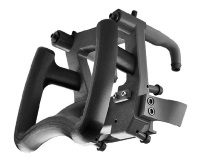New Year, New Strategy – Why you Should Implement 3D Printing for your Business
The most recent Wohlers Report states that the additive manufacturing industry grew to $5.1 billion dollars and shows no projected signs of slowing down over  the next four years. This growth in additive manufacturing is driven by designers and manufacturers finding value in using the technology to enable better ways of bringing products to life. As manufacturing moves into the 4th industrial revolution, where additive manufacturing is crucial, implementing new technologies is essential in order to gain a competitive edge.
the next four years. This growth in additive manufacturing is driven by designers and manufacturers finding value in using the technology to enable better ways of bringing products to life. As manufacturing moves into the 4th industrial revolution, where additive manufacturing is crucial, implementing new technologies is essential in order to gain a competitive edge.
Additive manufacturing, or 3D printing the more common term, is the process by which digital 3D design is used to build up a component in layers by depositing material. Since the 1980s, the use of 3D printing, along with the maturity of technology and materials, has driven the steady growth in replacing traditional manufacturing means. You can now commonly see manufacturers such as BMW, Oreck, and Airbus using 3D printing for applications ranging from prototypes to manufacturing floor tools.
 For a company like Thogus, who specializes in plastic part development, using 3D printing changed how they prototype to validate a design to the production of low volume parts. 3D printing saved a tremendous amount of cost and time completely changing how their business operates. “We save in excess of $150,000 per year with FDM 3D printing,” said Matt Hlavin, President of Thogus Products. “I can’t imagine not having this technology in a manufacturing setting. It is as critical to our business as email.”
For a company like Thogus, who specializes in plastic part development, using 3D printing changed how they prototype to validate a design to the production of low volume parts. 3D printing saved a tremendous amount of cost and time completely changing how their business operates. “We save in excess of $150,000 per year with FDM 3D printing,” said Matt Hlavin, President of Thogus Products. “I can’t imagine not having this technology in a manufacturing setting. It is as critical to our business as email.”
Major manufacturers that aren’t using 3D printing should do an internal review of what applications they could enhance by implementing additive manufacturing. The speed that 3D printing brings to manufacturing can be crucial to keeping projects on track. Receiving a CAD file from an internal design team and having that turned into a physical part in a matter of hours is extremely beneficial with rapid prototyping and an increasing time to market. At a time when winning bids for new business can be fierce, time is definitely money.
The advantages of using 3D printing are enabling manufacturers to do more in an economical way. With this evolution, it will become more commonplace to see 3D printing used for end use parts and manufacturing aids. As major 3D printing providers such as Stratasys and 3D Systems are striving to enhance their additive technologies, you can be sure that there will not be a decrease in growth in the near future.

 Blog
Blog